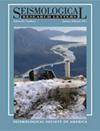Computing Theoretical Seismograms from a Point Source in a Spherical Multilayered Medium
IF 3.2
3区 地球科学
Q2 GEOCHEMISTRY & GEOPHYSICS
引用次数: 0
Abstract
Computing theoretical seismograms from a point source in a given Earth model is essential for modeling and inversion of observed seismic waveforms for Earth’s structure and earthquake source parameters. Here, we derived the propagator matrices and source terms for a spherical multilayered Earth model using the exact earth flattening transformation. We found that their differences from their counterparts in horizontal layered media are inversely proportional to the nondimensional horizontal wavenumber and its higher order. In addition, all the source terms in a spherical layered model have a source-depth dependent scaling factor that differs from in a horizontal layered model by up to 6% for deep earthquakes. The surface displacement produced by a point source can be obtained in a similar form as in horizontal layered media. Computation of theoretical seismograms was implemented using the generalized reflection and transmission coefficients method. Numerical tests show that our formulae and implementation are correct and efficient for computing full-wave seismograms, including the permanent displacements, at teleseismic distances up to 100°. Individual seismic phases can be isolated and analyzed semianalytically because the generalized reflection and transmission method is used. Furthermore, our analytic expression of displacement in terms of the propagator matrices and source terms can be used to derive analytic derivatives of seismograms for full-wave waveform inversion.计算球形多层介质中点震源的理论地震记录
在给定的地球模型中计算一个点源的理论地震记录对于模拟和反演地球结构和震源参数的观测地震波是必不可少的。在这里,我们利用精确的地球平坦化变换,导出了球形多层地球模型的传播子矩阵和源项。我们发现它们与水平层状介质中对应波的差异与无量纲水平波数及其高阶成反比。此外,对于深地震,球形层状模型中的所有震源项都具有与震源深度相关的比例因子,与水平层状模型中的比例因子相差高达6%。点源产生的地表位移可以用与水平层状介质类似的形式得到。采用广义反射和透射系数法对理论地震记录进行了计算。数值试验表明,我们的公式和实现对于计算100°远震距离下包括永久位移在内的全波地震记录是正确和有效的。由于采用了广义反射透射法,可以对地震相进行半解析分离和分析。此外,我们用传播矩阵和震源项表示的位移解析表达式可用于推导全波波形反演的地震记录解析导数。
本文章由计算机程序翻译,如有差异,请以英文原文为准。
求助全文
约1分钟内获得全文
求助全文
来源期刊

Seismological Research Letters
地学-地球化学与地球物理
CiteScore
6.60
自引率
12.10%
发文量
239
审稿时长
3 months
期刊介绍:
Information not localized
 求助内容:
求助内容: 应助结果提醒方式:
应助结果提醒方式:


